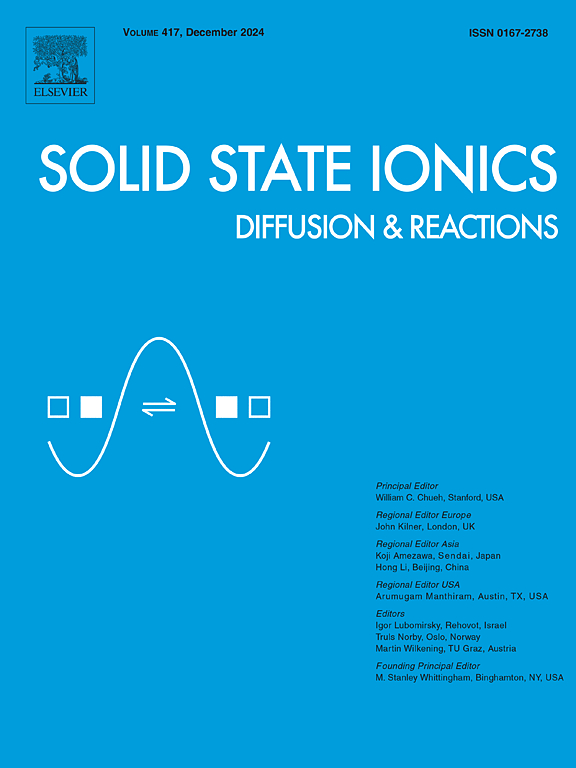用于固体氧化物燃料电池的多孔 La0.6Sr0.4CoO3-δ-Ce0.9Gd0.1O1.95 复合电极电化学性质增强因素的研究
IF 3
4区 材料科学
Q3 CHEMISTRY, PHYSICAL
引用次数: 0
摘要
在低温条件下提高固体氧化物燃料电池(SOFC)阴极电化学性能的一种方法是将两种结构不同的氧化物混合形成复合电极。为了了解由离子导电氧化物 Ce0.9Gd0.1O1.95 (GDC) 和离子与电子混合导电氧化物 La0.6Sr0.4CoO3-δ (LSC) 组成的复合电极的增强因子,我们进行了电化学测量,测量结果与组成比例、温度(673-1073 K)和氧分压(p(O2),1-10-4 bar)呈函数关系。在低温(T < 873 K)、高 p(O2) 区(1-10-1 巴),GDC 含量超过 40% 的样品通过阻抗谱获得的特定区域电导率(σE)有所提高。然而,在所有测得的 p(O2) 条件下,高温(T > 873 K)下的增强效果并不明显。虽然 GDC 取代了一些 LSC 颗粒,但仍能观察到复合电极化学电容的增强。这表明 GDC 颗粒在复合电极中起到了离子传导通道的作用。为了了解增强机制,我们将 σE 的实验数据与使用一维传输线模型(1-D TLM)计算得出的结果进行了比较,该模型只考虑了表面电阻率和离子电阻率的贡献。结果表明,σE 的测量结果与计算结果之间存在差异。讨论了造成差异的几种可能原因,其中三相边界反应电阻率的贡献在计算 σE 时不容忽视。本文章由计算机程序翻译,如有差异,请以英文原文为准。
Investigation of factors enhancing electrochemical properties of the porous La0.6Sr0.4CoO3-δ–Ce0.9Gd0.1O1.95 composite electrode for solid oxide fuel cell
One method for enhancing the electrochemical performance of a solid oxide fuel cell (SOFC) cathode at low temperatures is to mix two oxides with dissimilar structures to form a composite electrode. To understand the enhancement factor of the composite electrode consisting of an ionic conducting oxide, Ce0.9Gd0.1O1.95 (GDC), and a mixed ionic and electronic conducting oxide, La0.6Sr0.4CoO3-δ (LSC), electrochemical measurements were performed as a function of composition ratio, temperature (673–1073 K), and oxygen partial pressure (p(O2), 1–10−4 bar). The area-specific conductivity (σE) that was obtained from the impedance spectra was enhanced at low temperature (T < 873 K) in the high p(O2) region (1–10−1 bar) for the samples that contained above 40 % of GDC. However, the enhancement was not significant at high temperatures (T > 873 K) under all measured p(O2) conditions. Although some LSC particles were replaced by GDC, the enhancement of the chemical capacitance of the composite electrode was observed. This indicates that GDC particles function as ionic conducting pathways in the composite electrode. To understand the enhancement mechanism, the experimental data of σE were compared with the calculated results using a one-dimensional transmission-line model (1-D TLM) considering only the contributions of surface resistivity and ionic resistivity. Results indicate that there is a discrepancy between the measured result of σE and the calculated result. Several plausible reasons for the discrepancy were discussed, where the contribution of the triple phase boundary reaction resistivity could not be ignored in the calculation of σE.
求助全文
通过发布文献求助,成功后即可免费获取论文全文。
去求助
来源期刊

Solid State Ionics
物理-物理:凝聚态物理
CiteScore
6.10
自引率
3.10%
发文量
152
审稿时长
58 days
期刊介绍:
This interdisciplinary journal is devoted to the physics, chemistry and materials science of diffusion, mass transport, and reactivity of solids. The major part of each issue is devoted to articles on:
(i) physics and chemistry of defects in solids;
(ii) reactions in and on solids, e.g. intercalation, corrosion, oxidation, sintering;
(iii) ion transport measurements, mechanisms and theory;
(iv) solid state electrochemistry;
(v) ionically-electronically mixed conducting solids.
Related technological applications are also included, provided their characteristics are interpreted in terms of the basic solid state properties.
Review papers and relevant symposium proceedings are welcome.
 求助内容:
求助内容: 应助结果提醒方式:
应助结果提醒方式:


